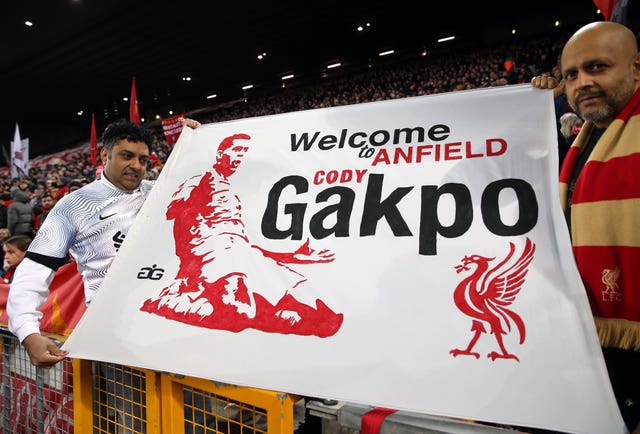
Premier League clubs spent a record £815m in the January transfer window to complete a season of unprecedented investment.
The gross spend for 2023’s window was 90 per cent higher than the previous record of £430m in 2018 and almost triple the previous January window (£295m).
The record for a full season had already been broken by a £1.92billion summer outlay, with that mark soon extended through £2bn for the first time and to an eventual total of £2.8bn – a new all-time high.
Calum Ross, assistant director in Deloitte’s Sports Business Group, told the PA news agency: “Record transfer spend in January, surpassing the previous record of £430m in January 2018.
“(In terms of) a seasonal spend in 2022-23, Premier League clubs are now over £2.5billion which highlights the level of capability of spend that they’ve got in the market at the moment.”
Premier League clubs also set a record for net transfer expenditure during a January window with a net spend of £720m, eclipsing the previous record set in January 2022 (£180m).
 Chelsea’s £300m-plus outlay alone would rank behind only 2018 among Premier League winter transfer windows (Stefan Rousseau/PA)
Chelsea’s £300m-plus outlay alone would rank behind only 2018 among Premier League winter transfer windows (Stefan Rousseau/PA)
As has been the trend in recent seasons, the English top flight far outpaced the rest of Europe – even the other members of the so-called ‘big five’ leagues in Spain, Italy, France and Germany.
Ross added: “When you look at the January transfer window alone, Premier League clubs have spent three times more than the other ‘big five’ leagues combined.
“And then when you look at seasonal spend, again, when you combine those other big five leagues together, the Premier League is spending more than all of those combined, which is just incredible.
 Liverpool welcomed the signing of Cody Gakpo (Barrington Coombs/PA)
Liverpool welcomed the signing of Cody Gakpo (Barrington Coombs/PA)
“You have the spend of the Premier League on a net basis at £1.5bn over the course of the season and then when you look at the other big five leagues as a collective, they’re actually in a net receipts position – so they’re actually receiving more from the sale of players than what they’re spending on players, which is quite stark (compared) to what you see in the Premier League.
“The Premier League was the only league of the big five that actually increased its media rights in the latest cycle, all the others either declined or stayed flat.
“There are obviously other things that come into that as well, when you look at new ownership at certain clubs, and also on-pitch performance is a big factor – whether that’s pushing for European competition or league titles, and then at the other end, just maintaining a place in the Premier League, is obviously a key driver of what’s going on across the market.”
Chelsea, under their new ownership group headed by Todd Boehly, continued to lead the way by signing World Cup winner Enzo Fernandez for a British record £106.8m while forward Mykhailo Mudryk joined from Shakhtar Donetsk in a deal reportedly worth up to £88.5m.
 Enzo Fernandez’s move set a new British record (Nick Potts/PA)
Enzo Fernandez’s move set a new British record (Nick Potts/PA)
The Blues’ £300m-plus outlay alone would rank behind only 2018 among Premier League winter transfer windows, and is more than the combined spend of all other clubs in the big five leagues this month.
Newcastle spent a reported £40m initial fee to bring forward Anthony Gordon from struggling Everton – who were the only club not to make a January signing – while Liverpool spent £38m on Netherlands international Cody Gakpo and Leeds broke their transfer record with a £35m move for Hoffenheim’s Georginio Rutter.
The previous record season saw £1.43bn spent in the summer of 2017 with the January window’s £430m making for a total of £1.86bn.
 Anthony Gordon was presented to the Newcastle fans at their Carabao Cup semi-final against Southampton (Owen Humphreys/PA)
Anthony Gordon was presented to the Newcastle fans at their Carabao Cup semi-final against Southampton (Owen Humphreys/PA)
This campaign has blown that out of the water and Ross sees no let-up in the near future.
“One of the good indicators is to look at the transfer spend as a percentage of revenue and on the net transfer spend, we’re looking at about a quarter of revenue being spent on transfers,” he said.
“That is a lot, it’s higher than it’s ever been, but I think – managed appropriately, with appropriate long-term business planning and financial control – I can see that continuing.”


Why are you making commenting on The Herald only available to subscribers?
It should have been a safe space for informed debate, somewhere for readers to discuss issues around the biggest stories of the day, but all too often the below the line comments on most websites have become bogged down by off-topic discussions and abuse.
heraldscotland.com is tackling this problem by allowing only subscribers to comment.
We are doing this to improve the experience for our loyal readers and we believe it will reduce the ability of trolls and troublemakers, who occasionally find their way onto our site, to abuse our journalists and readers. We also hope it will help the comments section fulfil its promise as a part of Scotland's conversation with itself.
We are lucky at The Herald. We are read by an informed, educated readership who can add their knowledge and insights to our stories.
That is invaluable.
We are making the subscriber-only change to support our valued readers, who tell us they don't want the site cluttered up with irrelevant comments, untruths and abuse.
In the past, the journalist’s job was to collect and distribute information to the audience. Technology means that readers can shape a discussion. We look forward to hearing from you on heraldscotland.com
Comments & Moderation
Readers’ comments: You are personally liable for the content of any comments you upload to this website, so please act responsibly. We do not pre-moderate or monitor readers’ comments appearing on our websites, but we do post-moderate in response to complaints we receive or otherwise when a potential problem comes to our attention. You can make a complaint by using the ‘report this post’ link . We may then apply our discretion under the user terms to amend or delete comments.
Post moderation is undertaken full-time 9am-6pm on weekdays, and on a part-time basis outwith those hours.
Read the rules here